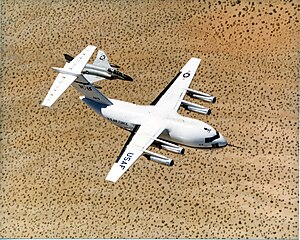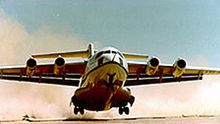McDonnell Douglas YC-15
| McDonnell Douglas YC-15 | |
|---|---|
 The YC-15 is escorted by an F-4 "Phantom II" |
|
| Type: | Strategic transporter prototype |
| Design country: | |
| Manufacturer: | |
| First flight: |
26th August 1975 |
| Commissioning: |
In flight testing |
| Production time: |
Was never mass-produced |
| Number of pieces: |
2 |
The McDonnell Douglas YC-15 is the prototype of a transport aircraft that McDonnell Douglas developed for the US Air Force in the 1970s .
development
In 1963 the US Air Force began planning to replace the Lockheed C-130 Hercules with a new type of transporter. The project then started to develop an aircraft with vertical / short take-off capability ( VSTOL ), however, turned out to be too complex. In the subsequent competition from 1972 without vertical take-off requirements called Advanced Medium STOL Transport (AMST) , two companies received orders to build two prototypes each : Boeing developed the YC-14 and McDonnell Douglas developed the YC-15, which later became the basis the McDonnell Douglas C-17 was to become.
In order to be able to meet the required STOL properties, both manufacturers used the principle of forced flow of aerodynamically effective surfaces to increase lift . While Boeing guided the engine jet over the upper side of the wing and the flaps in its YC-14 in order to be able to exploit the Coandă effect , McDonnell Douglas arranged the four engines of the YC-15 conventionally under the wings. In slow flight, large, double-slotted flaps protrude into the exhaust jet on the wing's trailing edge and deflect it downwards. Part of the jet also flows through the crevices over the top of the flaps, creating additional lift. The two prototypes built (registration numbers 72-1875 and 72-1876) had different spans : 40.4 meters and 33.6 m respectively.
The McDonnell Douglas YC-15 had its maiden flight on August 26, 1975 . By the end of the flight tests in 1977, the two prototypes had completed around 600 hours of flight. Although flight tests performed well with both competing models, neither the YC-15 nor the YC-14 went into series production for budget reasons. In November 1979 the US Department of Defense finally stopped the AMST program. When developing the C-17, McDonnell Douglas relied on the design of the YC-15.
From the end of August 1979, the machines were temporarily stored at AMARG . The first prototype built (72-1875) initially went to the nearby Pima Air & Space Museum , until McDonnell Douglas restored it to airworthy condition in 1996. This specimen has been registered under the civil registration number N15YC since April 1997. McDonnell Douglas and the US Air Force have since used it as a test aircraft for new technologies that could then be used on the C-17, saving the Air Force a C-17 test aircraft.
Since January 2009 the N15YC has stood as a gate guard in front of an entrance to Edwards AFB .
Technical specifications

| Parameter | Data |
|---|---|
| Type | Strategic transporter prototype |
| length | 37.90 m |
| span | 33.60 or 40.40 m |
| Wing area | 162 m² |
| Wing extension | 6.97 and 10.08, respectively |
| Wing loading |
|
| height | 13.20 m |
| Empty mass | 47,600 kg |
| Max. Takeoff mass | 98,286 kg |
| Top speed | 861 km / h |
| Max. Altitude | 9144 m |
| Max. Range | 4815 km |
| Engines | four Pratt & Whitney JT8D -17- turbofan engines with 71.20 kN thrust each |
Web links
Individual evidence
- ↑ Picture of the McDonnell Douglas YC-15A aircraft at airliners.net, accessed on August 9, 2011.